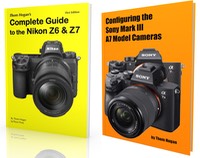(commentary)
Early on, the mirrorless makers thought that the lower-end cameras would be like the lower-end DSLRs and be the meat of the market that let them take away the DSLR thunder. In terms of volume, yes, the lower end of mirrorless still produces more volume than the higher end. Witness Olympus: 200k Pens, 50k OM-D E-M5's shipped in the first half of their fiscal year. But that's a little deceptive, as some of those Pens were the high-end Pen, the E-P5.
Ditto Nikon: a few hundred k worth of S1's and J3's shipped in the first half of the fiscal year.
Meanwhile, the low end DSLRs, while down a bit in overall sales, are still kicking out millions of units for both Canon and Nikon in that same time period.
What's happening here?
A squeeze that is exacerbated by price.
Below the low-end mirrorless you have high-end compacts. The Coolpix P330 is pretty competent and shirt-pocket small at US$330, and the Sony RX-100 is very good at US$600 and still fits in that same pocket. Worse still, the f/1.9 end of the RX-100's lens means that it can make up for its smaller sensor size when the kit lens for a mirrorless camera starts at f/3.5. So compacts are definitely squeezing from the lower end in terms of size, convenience, and quality.
An Olympus E-PM2 kit is US$500. A Nikon J3 kit is US$400. A Sony NEX-3N kit is US$450. Basically low-end mirrorless is now seriously overlapping in price with high-end compacts. And those are prices that have drifted down from where we were 18 months ago with entry mirrorless. Why? Because at the other end we have low-end DSLRs squeezing downwards. A brand new 24mp, APS-sensor sized D3200 kit is US$550 at the moment. So by buying one of the mirrorless options you don't save much money, you lose the viewfinder, you lose pixel count, you lose fast focus, though you do gain "smaller." But "smaller" is the realm of those compacts creeping upwards. See the problem?
Consider the 16mp Panasonic GM1 at US$750 with a 24-64mm (equivalent) f/3.5-5.6 lens versus that 20mp Sony RX-100 at US$600 with a 28-105mm (equivalent) f/1.9-4.9 lens. Image quality should basically be a push at the wide angle end, and close to even at the GM1's telephoto end. The Sony's a little smaller. The Panasonic has a few more interesting features, plus you can mount other lenses on it. Given that the average interchangeable lens camera buyer purchases a grand total of 1.5 lenses, a number of folk might just pick the Sony and not worry about other lenses.
Everyone's trying to get their product prices up into the US$500-1000 range, because that's where they'll get DSLR-like margins and perhaps profitability (or at least a positive ROI). So we're getting a log jam there: lots of compacts, mirrorless, DSLRs, all squeezed into a narrow dollar range. Something's going to lose that battle.


